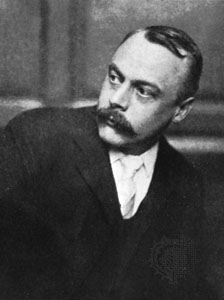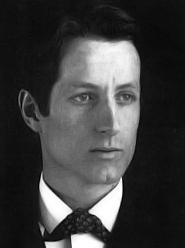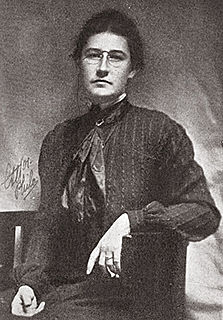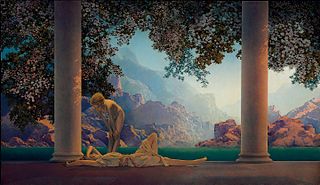
Hannes Bok, pseudonym for Wayne Francis Woodard, was an American artist and illustrator, as well as an amateur astrologer and writer of fantasy fiction and poetry. He painted nearly 150 covers for various science fiction, fantasy, and detective fiction magazines, as well as contributing hundreds of black and white interior illustrations. Bok's work graced the pages of calendars and early fanzines, as well as dust jackets from specialty book publishers like Arkham House, Llewellyn, Shasta Publishers, and Fantasy Press. His paintings achieved a luminous quality through the use of an arduous glazing process, which was learned from his mentor, Maxfield Parrish. Bok shared one of the inaugural 1953 Hugo Awards for science fiction achievement.

The Wind in the Willows is a children's book by the British novelist Kenneth Grahame, first published in 1908. Alternatingly slow-moving and fast-paced, it focuses on four anthropomorphised animals: Mole, Rat, Toad, and Badger. They live in a pastoral version of Edwardian England. The book was based on bedtime stories Grahame told his son Alastair. It has been adapted numerous times for both stage and screen.

Henry Patrick Clarke was an Irish stained-glass artist and book illustrator. Born in Dublin, he was a leading figure in the Irish Arts and Crafts Movement.

Kenneth Grahame was a Scottish writer born in Edinburgh, Scotland. He is most famous for The Wind in the Willows (1908), one of the classics of children's literature, as well as The Reluctant Dragon. Both books were later adapted for stage and film, of which A. A. Milne's Toad of Toad Hall, based on part of The Wind in the Willows, was the first. Other adaptations include Cosgrove Hall Films' The Wind in the Willows, and the Walt Disney films.

An illustration is a decoration, interpretation or visual explanation of a text, concept or process, designed for integration in print and digital published media, such as posters, flyers, magazines, books, teaching materials, animations, video games and films. An illustration is typically created by an illustrator. Digital illustrations are often used to make websites and apps more user-friendly, such as the use of emojis to accompany digital type. llustration also means providing an example; either in writing or in picture form.

Maxfield Parrish was an American painter and illustrator active in the first half of the 20th century. He is known for his distinctive saturated hues and idealized neo-classical imagery. His career spanned fifty years and was wildly successful: His painting Daybreak (1922) is the most popular art print of the 20th century.

Arthur Rackham was an English book illustrator. He is recognised as one of the leading figures during the Golden Age of British book illustration. His work is noted for its robust pen and ink drawings, which were combined with the use of watercolour, a technique he developed due to his background as a journalistic illustrator.

Edmund Dulac was a French British naturalised magazine illustrator, book illustrator and stamp designer. Born in Toulouse he studied law but later turned to the study of art at the École des Beaux-Arts. He moved to London early in the 20th century and in 1905 received his first commission to illustrate the novels of the Brontë Sisters. During World War I, Dulac produced relief books and when after the war the deluxe children's book market shrank he turned to magazine illustrations among other ventures. He designed banknotes during World War II and postage stamps, most notably those that heralded the beginning of Queen Elizabeth II's reign.
"The Reluctant Dragon" is an 1898 children's story by Kenneth Grahame, originally published as a chapter in his book Dream Days. It is Grahame's most famous short story, arguably better known than Dream Days itself or the related 1895 collection The Golden Age. It can be seen as a prototype to most modern stories in which the dragon is a sympathetic character rather than a threat.

Moses Harris was an English entomologist and engraver.
Edward Hutton was a British author of travel books and various Italian subjects. During World War II he aided in the protection of Italian historical sites.

Jessie Willcox Smith was an American illustrator during the Golden Age of American illustration. She was considered "one of the greatest pure illustrators". She was a contributor to books and magazines during the late 19th and early 20th centuries. Smith illustrated stories and articles for clients such as Century, Collier's, Leslie's Weekly, Harper's, McClure's, Scribners, and the Ladies' Home Journal. She had an ongoing relationship with Good Housekeeping, which included the long-running Mother Goose series of illustrations and also the creation of all of the Good Housekeeping covers from December 1917 to 1933. Among the more than 60 books that Smith illustrated were Louisa May Alcott's Little Women and An Old-Fashioned Girl, Henry Wadsworth Longfellow's Evangeline, and Robert Louis Stevenson's A Child's Garden of Verses.

Daybreak is a painting by American artist Maxfield Parrish made in 1922. Daybreak, inspired by the landscape of Vermont and New Hampshire to create lush and romantic tones, is regarded as the most popular art print of the 20th century, based on number of prints made: one for every four American homes. According to the National Museum of American Illustration, it has outsold Andy Warhol's Campbell's Soup Cans and Da Vinci's Last Supper. It is still in print. The painting is also part of the core of the neo-classical popular paintings that started to gain traction at the beginning of the 1920s. His work in his staple style was also popularized by the large scale murals he painted in the 1930s.
The Golden Age is a collection of reminiscences of childhood, written by Kenneth Grahame and first published in book form in 1895, by The Bodley Head in London and by Stone & Kimball in Chicago. The Prologue and six of the stories had previously appeared in the National Observer, the journal then edited by William Ernest Henley. Widely praised upon its first appearance – Algernon Charles Swinburne, writing in the Daily Chronicle, called it "one of the few books which are well-nigh too praiseworthy for praise" – the book has come to be regarded as a classic in its genre.

The National Museum of American Illustration (NMAI), founded in 1998, is the first national museum to be devoted exclusively to American illustration artwork. The NMAI is located on Newport, Rhode Island's historic Bellevue Avenue in the mansion Vernon Court, designed by the noted Gilded Age architecture firm Carrère and Hastings. The museum's collection contains over 2,000 original works by noted American illustrators such as Norman Rockwell, Maxfield Parrish, J. C. Leyendecker, N.C. Wyeth, and others.

The term Golden Age comes from Greek mythology, particularly the Works and Days of Hesiod, and is part of the description of temporal decline of the state of peoples through five Ages, Gold being the first and the one during which the Golden Race of humanity lived. After the end of the first age was the Silver, then the Bronze, after this the Heroic age, with the fifth and current age being Iron.
Helen Isobel Mansfield Ramsey Stratton was a British artist and book illustrator.

Cosmic Knights is an anthology of themed fantasy and science fiction short stories on the subject of knights edited by Isaac Asimov, Martin H. Greenberg and Charles G. Waugh. The third volume in their Isaac Asimov's Magical Worlds of Fantasy series, it was first published in paperback by Signet/New American Library in January 1985. The first British edition was issued in trade paperback by Robinson in July 1987.
Inga Moore is an Anglo-Australian author and illustrator of books for children.














